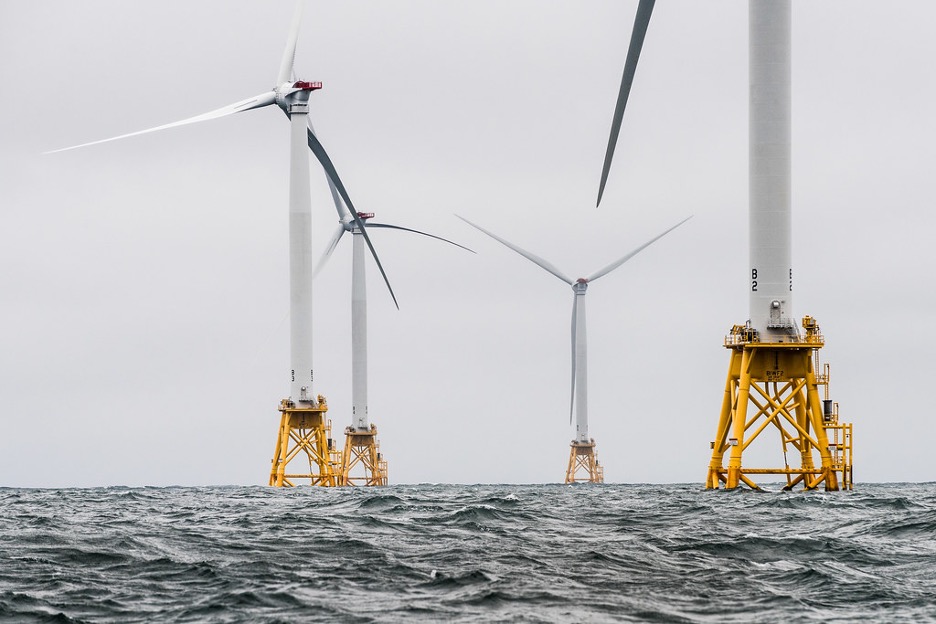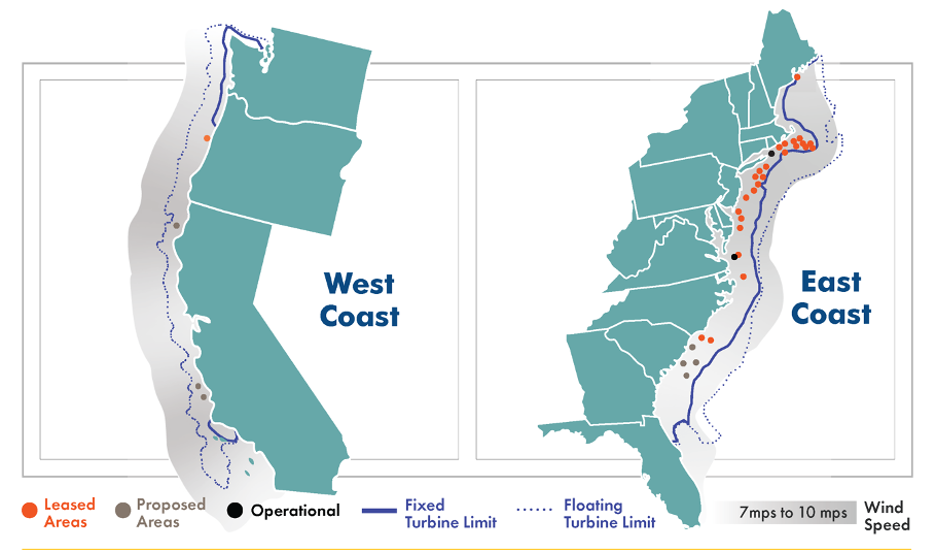
Offshore wind is becoming a powerful player in the renewable energy space. Wind turbines fixed on platforms in large bodies of water can generate strong, steady power even through the night—giving them an edge over onshore wind power. And coastal locations ideal for offshore wind are closer to population centers, making connections to transmission lines easier and less costly. Added to that, there is enormous technical resource potential for offshore wind—economic factors aside, the United States could build enough offshore wind turbines to nearly triple our annual electricity generation! Yet the United States has only two operating offshore wind farms today: Block Island Wind Farm off the coast of Rhode Island and Coastal Virginia Offshore Wind (a pilot project) off the shores of Virginia Beach.
While the U.S. offshore wind industry is newer than in Europe, several factors limit its growth. These factors include siting challenges such as water depth, competing coastline use, and the need for community support.
Water Depth: Did you know that there are far more leases for offshore wind farms on the East Coast of the United States than the West Coast? One of the reasons is water depth. Fixed wind turbines (like those at Block Island) are built into the seabed, and it is difficult to install them in waters deeper than about 200 feet. While on the East Coast, the water depth descends more gradually, the West Coast continental shelf drops off steeply to depths of 13,000 feet (4,000 meters). This limits the potential for West Coast offshore wind installation. In fact, the U.S. Department of Energy estimated that approximately 60 percent of the country’s offshore wind potential is situated in waters that are too deep for turbines to be fixed to the seabed. This limitation is leading federal and private institutions to develop technologies such as floating turbine platforms.

Competing Coastline Use: Another factor limiting offshore wind potential on the West Coast is that some coastline areas are already claimed for other uses, including military operations and environmental sanctuaries. The U.S. military has mostly blocked offshore wind development in southern California (except for Morro Bay and Diablo Canyon regions) over concerns that turbines may interfere with aerial and coastal training at military bases. Wildlife sanctuaries (including Monterey Bay National Marine Sanctuary) occupy much of the central California coast and northern Washington, further limiting West Coast installation for offshore wind. There is potential for offshore wind farms to protect ocean ecosystems by preventing other maritime activity in the area, although scientists have yet to fully understand the impacts of offshore wind on ecosystems.
Need for Community Support: Some communities oppose offshore wind farm installation for fear that it will devalue property by obstructing coastal views or impacting public beach use. Studies on the impacts to property values of onshore and offshore wind farms show mixed results (2018, 2013), as do those on beach use and coastal tourism (2020, 2010). It is important for industrial leaders to work with communities to gain support for installation projects and understand the communities that they serve. And the Bureau of Ocean Energy Management—the federal gatekeeper for offshore wind energy projects—encourages companies to seek community participation.
Awareness of offshore farm siting considerations is more important than ever. As part of its climate initiative, the Biden administration aims to establish 30 gigawatts of offshore wind power on U.S. coasts by 2030. The Energy Futures Initiative (EFI), as part of the Labor Energy Partnership with the American Federation of Labor and Congress of Industrial Organizations (AFL-CIO), has hosted two stakeholder workshops on building an offshore wind industry that is equitable and sustainable. See our workshop summary reports: The Future of Offshore Wind Energy in the United States (2021) and Building a Domestic Offshore Wind Supply Chain (2022). Alongside the 2022 report, we published four Labor Energy Partnership-commissioned white papers on topics including manufacturing, shipbuilding, and policy to drive development of the offshore wind supply chain. For some basics on the offshore wind industry, see our fact sheet: The Power of Offshore Wind.
– Angie Kaufman & Alicia Moulton
(Share this post with others.)




